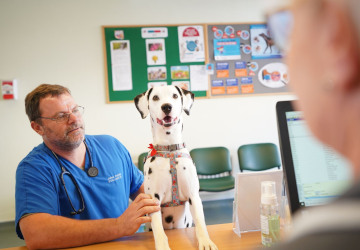
Caring for an arthritic dog at home – get our free guide
September 14, 2022
Just like in humans, a dog’s joints can stiffen and cause discomfort as they get older. Osteoarthritis affects over 80% of dogs over the age of 8 years (and some younger dogs too). To support Animal Pain Awareness Month, the Veterinary Surgeons at Edgewood Vets are helping dog owners in Essex understand how to spot signs of pain and support their dog’s journey with this disease at home.
Adaptations for Arthritic Dogs
Signs and symptoms of canine arthritic pain can be difficult to see, especially when it is often subtle and intermittent. Dogs cannot tell us how they feel and are good at hiding pain and just ‘carrying on’. Therefore, it is no wonder that such a huge percentage are overlooked until they are at the latter stages of this debilitating disease.
Vet Jürgen Theinert explains that some of the symptoms of Osteoarthritis in dogs include:
- Reluctance to exercise
- Licking, biting, or overgrooming an area
- Lameness or subtle shifting
- Gait changes in how they walk and run
- Struggling to get up from lying down
- Unable to jump on and off things
- Struggling with stairs
- No longer wanting to play
- Behaviour changes
If you notice any of these signs in your pet, Jürgen advises that is best to get them looked at sooner rather than later – contact us to book a pain appointment. Arthritis can be very painful for pets and will affect their quality of life on a daily basis.
If your Vet is concerned, simple osteoarthritis x-rays can be taken to confirm diagnosis and then a treatment plan put in place. It is important to understand with arthritis that it is often a ‘multimodal’ treatment approach as there are many aspects that need to be considered. Part of this approach may include:
- Drug therapy pain management
- Physiotherapy
- Hydrotherapy
- Regenerative medicine
- Supplements
- Diet adaptations
- Home adaptations
It may be that 1 or 2 of these treatments are implemented initially and more built in as the disease progresses, but every patient is different and so will be their treatment programme.
As well as the treatments available there are also some simple home and exercise adaptations and that can be made to improve your arthritic dog’s quality of life. The Vets at our Purleigh clinic have pooled their best advice in a downloadable guide – get this here.
Get our Dog Arthritis Home Guide
There are many fantastic resources available to owners to help manage their arthritic pet’s condition at home. Speak to our team at Edgewood Vets about the support we can offer to your pet and you – get in touch.
You may also find the Canine Arthritis Management website helpful as it has advice and products for arthritic dogs – visit it now.






